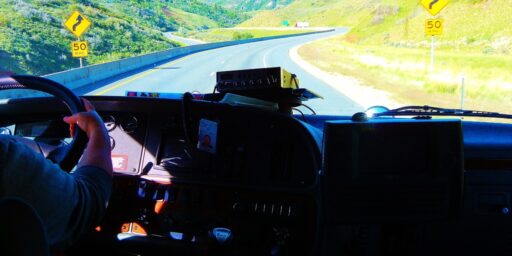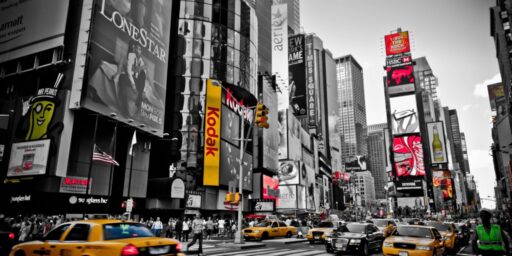Are Unregulated Roads Safer?
A Path to Road Safety With No Signposts [RSS] (NYT)
“I WANT to take you on a walk,” said Hans Monderman, abruptly stopping his car and striding – hatless, and nearly hairless – into the freezing rain. Like a naturalist conducting a tour of the jungle, he led the way to a busy intersection in the center of town, where several odd things immediately became clear. Not only was it virtually naked, stripped of all lights, signs and road markings, but there was no division between road and sidewalk. It was, basically, a bare brick square. But in spite of the apparently anarchical layout, the traffic, a steady stream of trucks, cars, buses, motorcycles, bicycles and pedestrians, moved along fluidly and easily, as if directed by an invisible conductor. When Mr. Monderman, a traffic engineer and the intersection’s proud designer, deliberately failed to check for oncoming traffic before crossing the street, the drivers slowed for him. No one honked or shouted rude words out of the window. “Who has the right of way?” he asked rhetorically. “I don’t care. People here have to find their own way, negotiate for themselves, use their own brains.”
Used by some 20,000 drivers a day, the intersection is part of a road-design revolution pioneered by the 59-year-old Mr. Monderman. His work in Friesland, the district in northern Holland that takes in Drachten, is increasingly seen as the way of the future in Europe. His philosophy is simple, if counterintuitive. To make communities safer and more appealing, Mr. Monderman argues, you should first remove the traditional paraphernalia of their roads – the traffic lights and speed signs; the signs exhorting drivers to stop, slow down and merge; the center lines separating lanes from one another; even the speed bumps, speed-limit signs, bicycle lanes and pedestrian crossings. In his view, it is only when the road is made more dangerous, when drivers stop looking at signs and start looking at other people, that driving becomes safer. “All those signs are saying to cars, ‘This is your space, and we have organized your behavior so that as long as you behave this way, nothing can happen to you,’ ” Mr. Monderman said. “That is the wrong story.”
The Drachten intersection is an example of the concept of “shared space,” a street where cars and pedestrians are equal, and the design tells the driver what to do. “It’s a moving away from regulated, legislated traffic toward space which, by the way it’s designed and configured, makes it clear what sort of behavior is anticipated,” said Ben Hamilton-Baillie, a British specialist in urban design and movement and a proponent of many of the same concepts.
Highways, where the car is naturally king, are part of the “traffic world” and another matter altogether. In Mr. Monderman’s view, shared-space schemes thrive only in conjunction with well-organized, well-regulated highway systems. Variations on the shared-space theme are being tried in Spain, Denmark, Austria, Sweden and Britain, among other places. The European Union has appointed a committee of experts, including Mr. Monderman, for a Europe-wide study.
MR. MONDERMAN is a man on a mission. On a daylong automotive tour of Friesland, he pointed out places he had improved, including a town where he ripped out the sidewalks, signs and crossings and put in brick paving on the central shopping street. An elderly woman crossed slowly in front of him. “This is social space, so when Grandma is coming, you stop, because that’s what normal, courteous human beings do,” he said.
Very interesting, indeed. It’s certainly counter-intuitive. I’ve long thought that human judgment should be allowed to override signs and signals–for example, drivers should not have to wait for a light to turn green at 2 a.m. when there are clearly no cars coming the other way–but it has never occured to me that removing all signs would work.
On the other hand, we do somehow manage to get people out of unlighted intersections at, for example, gas stations and supermarkets. In the D.C. area, we also manage to negotiate toll roads in which four lanes of traffic suddenly diverge into eight toll lanes and then merge back into four traffic lanes without so much as lane markers. Monderman’s experiment is worth keeping an eye on.




When hurricane Charley removed electric from my area, I was fascinated to note that the traffic flow at an intersection nearby (normally regulated by a traffic light) was actually improved.
It was only when the police intervened and barred left and right turns from that intersection (something they thought would help, I guess…) that the traffic snarled up again.
Oops. Barred left turns… sorry. It snarled up because everyone was taking right turns into the side streets and then doing u–turns so they could get to the left they actually wanted to make.
Gee! Now we can save all that money we have been paying traffic engineers.
So when drivers aren’t told by signs and lights what to do, they use their brains. Astonishing.
From my own experience, where there is brick paving most people drive more cautiously, probably because they expect pedestrians to be present.
from personal observation driving in Berlin and Paris I can confirm that the French get by with a lot less regulation and everyone is paying attention to what the other people are doing, whereas Germans tend to mind what is allowed to them and expecting everyone else to do the same, consequently paying less attention to what the others are actually doing.
I am however sceptical of the “no rules” approach in that (a) it’s as yet unclear in how much it simply freerides on regulations and norms established elsewhere and (b) how well it works if damages have to be settled in court. There are obviously cases where two rational agents can have perfectly reasonable expectations and make perfectly reasonable decisions, which in agregate lead to unfortunate consequences. A simple miscommunication in “who goes first” is enough and without explicit rules I’m unsure how to resolve such a case. (Splitting the difference of course favours the rich and the reckless.)